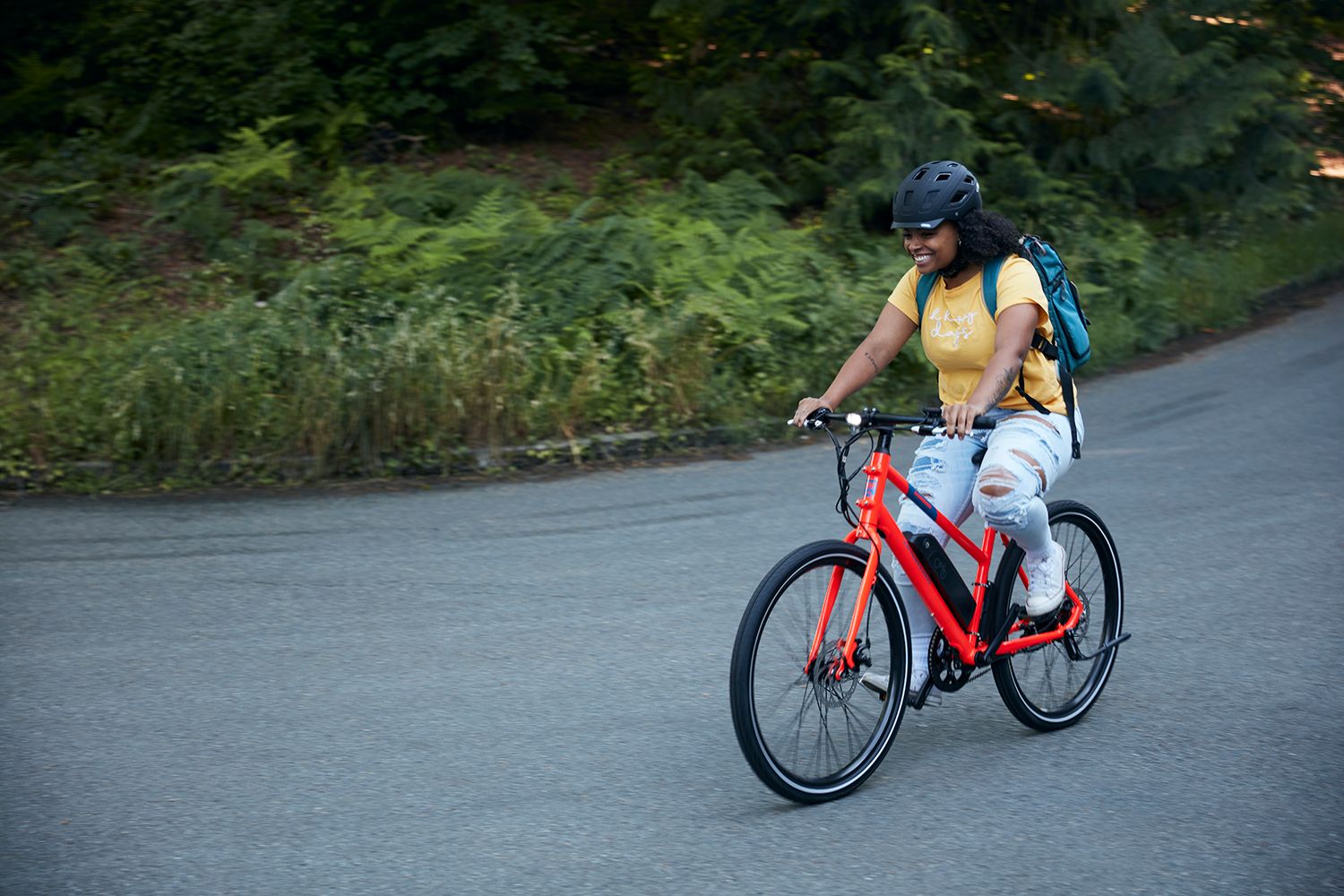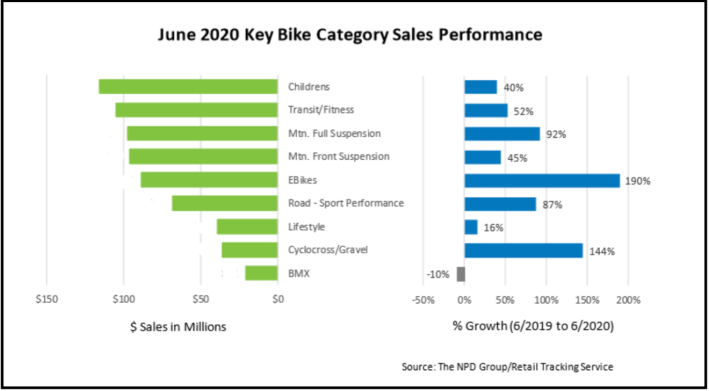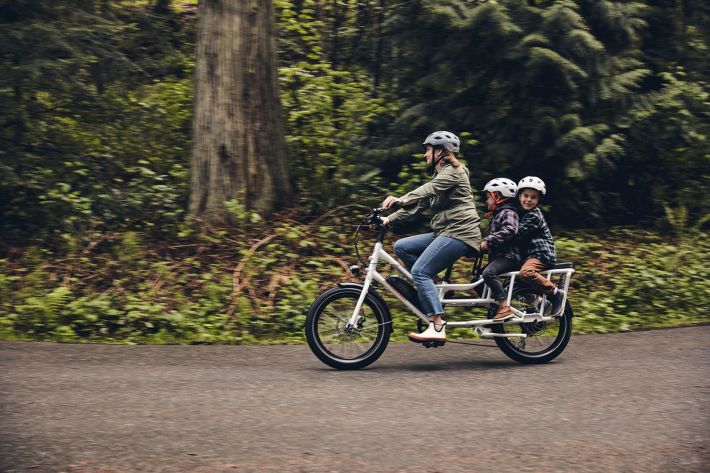How To Get More People on E-Bikes
1:17 AM EDT on September 2, 2020

Courtesy: Rad Power Bikes
Thanks to COVID-19, e-bike sales have nearly tripled in recent months — but if we want them to become a major part of our transportation fleet, we'd need to make them even more accessible.
Market researchers at the NPD group found that sales of pedal-assist bikes grew faster than any other segment of the cycling market in the month of June, following historic growth in March, April, and May. The trend may indicate that new riders are more focused on biking for transportation, rather than simply as a sport: More than 65 percent of people who purchase bikes with pedal-assist motors report that that they bought the vehicle mostly to replace car trips, according to a study from Portland State University. By contrast, more than half of people who own traditional bikes ride them exclusively for recreation.

The sales surge is notable given how slowly Americans have adopted e-bikes in previous years, despite the benefits for would-be riders — especially ones who are older, mobility-impaired, or simply don't want to arrive to work sweaty.
Until 2012, e-bikes represented less than one percent of global bike sales, and Europeans bought more than 19 times as many as Americans. But when advances in lithium-ion batteries began to drive down the costs of e-bikes in the mid 2010s, pedal-assist options exploded in popularity — a trend that accelerated as the pandemic forced frightened commuters in the essential professions off of buses and trains.
But even with more easy-to-ride e-bikes in American households, cycling still accounts for less than two percent of household trips under three miles today. As America continues its pandemic-prompted experiment in active transportation, e-bike advocates are hoping that they can get those numbers up — and car trips down — with a few shifts to increase adoption.
Here's are a few of policy, design, and culture changes that might need to happen first — and why old-style cycling advocacy probably won't work for a pedal-assisted future.
1. Stop trying to sell e-bikes to cyclists — and start selling them to everyone else
Bikes have long carried the reputation of being the favored mode of gearhead white men who also ride for sport — despite the fact that men of color may cycle the most, and most cyclists are neither would-be athletes nor would-be bike mechanics.
But the cycling industry — and the manufacturers and the bike shops that are often the consumers' first contact with it — often fail to cater to the needs of the many people who might try an approachable option like e-cycling.
The most successful e-bike companies, by contrast, recognized early that the e-bike might appeal to the millions of people who don't bike yet. And centering those riders' needs might require a whole new approach to bike design, sales, and much more.
"We're not exactly a bike company — we're a transportation company. And because of that, our e-bikes are not frequently compared to traditional bikes," said Mike Radenbaugh, CEO and founder of Seattle-based Rad Power Bikes, which he says is leads the industry in U.S. sales. "Most of them are north of 65 pounds, and they all have big batteries for long range, big tires to make riding on rough city roads safer and more comfortable, and just a very utilitarian product design philosophy overall. If we made the kind of light-weight commuter design with skinny tires that was influenced by European sport cycling — yeah, it might look more like a traditional bike. But there are a lot of traditional bikes already."
The traditional bike industry could probably learn something from that attitude, too, and seek to broaden its options and customer base. But to expand e-bike sales, catering to the non-cyclist might be essential.

2. Make them cheaper
A bike frame with a battery and a motor, of course, costs more than the same bike frame alone. But many e-bike shoppers are shocked by just how much more retailers charge for pedal-assist bikes: an average of about $4,750, or only a few thousand dollars cheaper than a cheap used car. The average cost of a comfort bike without a motor, by contrast, will run you somewhere between $300 and $600 dollars.
Electric cargo bikes — which are popular among women, who are more likely to shoulder household responsibilities like hauling groceries and picking up children — can cost far more, and financing is rarely available.
Industry insiders say those prices come from big bike shop mark-ups, as well as the industry's emphasis on high-end components, low vehicle weight, and ultra-customizable designs — all things that the average transportation cyclist might not need, and might even find intimidating. Cheaper, reliable options exist, and industry insiders say these are driving our current e-bike surge — but companies tend to cut out local bike shops by selling vehicles directly to consumers.
An affordable e-bike could come to a bike shop near you, industry experts argue, if bike manufacturers rethink their assumptions and start keeping it simple.
"We get to that low price point, honestly, because we innovate, we standardize, and frankly, we simplify," says Radenbaugh, who cites his bikes' reliance on big tires to absorb road shock rather than expensive suspension systems as one example. "We're more focused on delivering products that have all the basic features that our customers need and want, versus constantly trying to differentiate ourselves in a really crowded marketplace."
3. Bust bad e-bike policy — and implement good ones
Since they began to grow in popularity in the mid 2000s, e-bikes have faced opposition from transportation leaders who failed to distinguish them from motorcycles and stigmatized the mode as a safety threat.
Many states still require certain e-bike riders to hold drivers licenses or stay out of bike lanes — despite the fact that most e-bikes top out at around 20 miles per hour, which is just two miles faster than a fit-but-not-speedy commuter on an analog bike. Recent studies that showed that e-bike riders had higher rates of serious injuries than traditional cycling have largely been debunked for their failure to consider the role cars played in the crashes, and because few riders over the age of 18 appear to get hurt — and children who operate all kinds of motorized vehicles tend to have high crash rates.
As states and cities work to dismantle bad e-bike policy, they may need to subsidize e-bike purchases, as have some countries have done. Scotland and Paris have offered their citizens cash or zero-interest financing to acquire pedal-assist vehicles, and the state of California made headlines for giving a small number of communities financing to buy electric bikes under the same umbrella as the program that subsidizes the purchase of electric cars. Expanding these programs could get more bikes on the street — and if national politicians were really smart, they'd make federal programs a part of their climate plans. Increasing e-bike adoption for just 15 percent of short trips could save the climate 12 percent in emissions every year, even if the rider replaces a trip in an electric car — a huge step towards achieving the Paris Climate accords.
4. Make our streets better for all bikes — electric or not
In the end, many of the most daunting barriers to e-bike adoption are the same as those to manual bike adoption. And before you ask, yes: we can end traffic violence, police brutality against people of color, harassment and other forms of violence against marginalized gender identities and sexual orientations, rampant bike theft, and the many other hurdles Americans face to riding on two wheels.
Radenbaugh notes that the cities with the highest e-bike adoption rates are those with the broadest commitments to safety — especially when it comes to creating dedicated biking infrastructure.
"Cities that have made a big investment in cycling infrastructure are also the cities where we’ve seen the most sales," he says. "They just outpace sister cities in the same region."
If that commitment was extended to addressing all the barriers to e-cycling, there's no telling what our streets might look like — and how many lives we might save.
Kea Wilson has more than a dozen years experience as a writer telling emotional, urgent and actionable stories that motivate average Americans to get involved in making their cities better places. She is also a novelist, cyclist, and affordable housing advocate. She previously worked at Strong Towns, and currently lives in St. Louis, MO. Kea can be reached at kea@streetsblog.org or on Twitter @streetsblogkea. Please reach out to her with tips and submissions.
Read More:
Stay in touch
Sign up for our free newsletter
More from Streetsblog USA
Friday’s Headlines Got Served
Another day, another GOP lawsuit trying to overturn a Biden administration climate change rule.
Disabled People Are Dying in America’s Crosswalks — But We’re Not Counting Them
The data on traffic fatalities and injuries doesn’t account for their needs or even count them. Better data would enable better solutions.
LA: Automated Enforcement Coming Soon to a Bus Lane Near You
Metro is already installing on-bus cameras. Soon comes testing, outreach, then warning tickets. Wilshire/5th/6th and La Brea will be the first bus routes in the bus lane enforcement program.
Talking Headways Podcast: Charging Up Transportation
This week, we talk to the great Gabe Klein, executive director of President Biden's Joint Office of Energy and Transportation (and a former Streetsblog board member), about curbside electrification.
Why Does the Vision Zero Movement Stop At the Edge of the Road?
U.S. car crash deaths are nearly 10 percent higher if you count collisions that happen just outside the right of way. So why don't off-road deaths get more air time among advocates?




